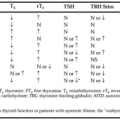SYSTEMIC EFFECTS OF THYROID HORMONE DEFICIENCY
Part of “CHAPTER 45 – HYPOTHYROIDISM“
The clinical spectrum of thyroid hormone deficiency ranges from the asymptomatic person without abnormal physical findings to the classic myxedematous patient in whom the diagnosis can readily be made on physical examination. Physical findings are most striking in young, otherwise healthy patients. Advanced age or nonthyroidal disease can commonly produce symptoms or physical findings that suggest thyroid disease and require thyroid function tests to aid in a diagnosis.
Thyroid hormone deficiency causes generally decreased oxygen consumption and defects specific to individual organs. The common symptoms of thyroid hormone deficiency include lethargy and decreased physical ability. The decrease in tissue calorigenesis results in cold intolerance.
SKIN AND CUTANEOUS APPENDAGES
In myxedema, the epidermis demonstrates an atrophied cellular layer with hyperkeratosis of traumatized areas. The dermis is infiltrated with mucopolysaccharides, hyaluronic acid, and chondroitin sulfate, resulting in increased fluid retention and nonpitting edema. Acinar gland secretion is decreased. On physical examination, decreases in surface temperature and pallor, resulting from cutaneous vasoconstriction, are observed. These changes produce the cool, dry roughness of the skin of the myx-edematous patient (see Chap. 218). The hair and nails are brittle. Hair loss is common, but it usually is reversible with treatment.
GASTROINTESTINAL SYSTEM
The usually modest weight gain in hypothyroidism probably is the result of a decreased metabolic rate. Marked obesity does not result from thyroid hormone deficiency. The sense of taste is decreased. Gastric atrophy and decreased gastric acid production are common. Antiparietal cell antibodies are present in approximately one-third of patients, and pernicious anemia has been reported in 10%.13 Constipation is a common symptom, but ileus is seen only in patients with severe myxedema. Ascites is rarely evident, although it may exist in the markedly myx-edematous patient who may also have pericardial and pleural effusions (see Chap. 204).
CARDIOVASCULAR SYSTEM
Cardiac function is affected by hypothyroidism; however, this is significant only in patients with coexistent cardiac disease. There is decreased contractility, decreased cardiac output, and diminished cardiac oxygen consumption in hypothyroid patients.14 In hypothyroid patients without coexisting heart disease, low exercise tolerance and shortness of breath on exertion may be partially caused by decreased cardiac function, but symptoms and signs specific for congestive heart failure usually are absent. In the patient with an already compromised heart, hypothyroidism may cause significant further deterioration. However, the lower tissue demands for cardiac output and tissue oxygenation may compensate for poor cardiac function (see Chap. 203). Unless ventricular function is compromised by a large myxedematous pericardial effusion, the authors believe that clinically significant cardiac dysfunction very rarely results from hypothyroidism. Occasionally, severe congestive heart failure coexists in patients with hypothyroidism. Such patients should be given thyroxine (T4) with caution. The potential benefit of T4 would be to increase contractility and cardiac output. The potential harm would be that increased myocardial oxygen requirements might further compromise a failing heart.
The diagnosis of autoimmune thyroid disease per se did not increase the risk of ischemic heart disease after a 20-year follow-up.15 However, elevations of serum lipids in hypothyroid patients are likely risk factors for coronary artery disease. The component of the hyperlipidemia that is due to thyroid hormone deficiency is variable, and it resolves after normalization of thyroid hormone levels. Because myocardial oxygen consumption is augmented by thyroid hormone, a hypothyroid patient with a deficient coronary artery circulation may not tolerate full replacement doses.
RESPIRATORY SYSTEM
In the absence of primary respiratory disease, the diminution of respiratory function in the hypothyroid patient is not significant. These patients have measurably decreased responses to hypoxia and hypercapnea, but usually this lack of response is of little clinical importance. However, respiratory muscle function may be seriously affected in the severely myxedematous patient, in whom hypoventilation may occur. Hypothyroidism may be a reversible component in rare patients with clinically significant sleep apnea syndrome.16 Myxedematous patients experiencing sleep apnea syndrome often have pharyngeal obstruction due to macroglossia. In the patients requiring prolonged mechanical ventilation, aggressive T4 replacement may facilitate weaning from the respirator. However, coexisting heart disease may limit the dosage of T4 that may be given safely (see also Chap. 202).
Stay updated, free articles. Join our Telegram channel

Full access? Get Clinical Tree






